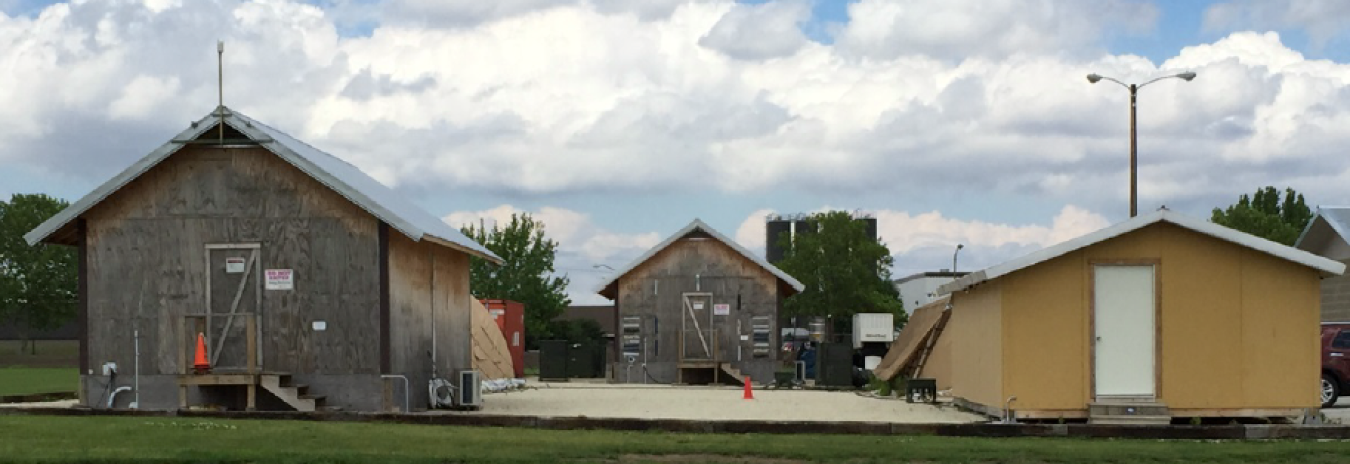
The U.S. Army Corps of Engineers Hut test site in Champaign, Illinois. ORNL used EnergyPlus to model the performance of the original B-Hut (middle), insulated B-Hut (left) and SIP Hut (right).<br />Credit: Oak Ridge National Laboratory.

NREL monitored—and used EnergyPlus to model—these two soft-sided shelters to understand the impacts of shelter configuration and operation on energy consumption.<br />Credit: National Renewable Energy Laboratory
Saving energy reduces the need for energy production and resulting greenhouse gas emissions, benefiting the climate and helping to improve and even save lives in the future. But when can saving energy help save lives directly? When that energy is saved at forward operating bases (FOBs) in hostile areas. During the wars in Iraq and Afghanistan, one of eight U.S. Army casualties occurred during an attack on a refueling convoy. Between 2003 and 2007, more than 3,000 lives were lost in this manner. Reducing fuel use at FOBs reduces the need for vulnerable and dangerous resupply missions.
For the past several years, researchers at Oak Ridge National Lab (ORNL) and the National Renewable Energy Lab (NREL) have been working with different branches of the U.S. military to evaluate the energy efficiency and air quality of alternative designs of FOB structures. Detailed energy simulation using DOE’s EnergyPlus engine has been an important component of these projects.
The ORNL team, led by Dr. Som Shrestha has been working with the Army Corps of Engineers (USACE) to reduce the energy consumption and assembly time of temporary barrack huts, commonly known as B-Huts. A typical 16 ft. x 32 ft. B-Hut has a wooden frame, uninsulated plywood sheathing, and a corrugated metal roof. It takes a week to assemble and uses as much as 13,000 kWh per year, with most of that going to heating. COL Fred Meyer and LTC Steven Hart of the US Military Academy (USMA) at West Point developed an alternative construction that uses Structural Insulated Panels (SIPS), pre-assembled panels with rigid insulation sandwiched between two pieces of oriented strand board (OSB). The SIP design dramatically reduces infiltration as well as the heating and cooling load, can be assembled by four soldiers in less than four hours, and can even be disassembled, repacked, and reused in a different location.
The ORNL team evaluated the performance of B-Huts, insulated B-Huts, and SIP Huts at the USACE facility in Champaign, IL. They created detailed EnergyPlus models of the huts, calibrated them using measured data, and used them to predict performance at other climate conditions. The models showed that in additional to constructability and reusability benefits, the SIP Hut will reduce total energy consumption by 40%. According to the project report published by USACE, “the SIP Hut has excellent building envelope air tightness, can maintain acceptable IAQ levels with proper ventilation, and may potentially use only about one-forth of the heating energy and one-sixth of the cooling energy required by an ordinary B-Hut...The SIP Hut offers potential energy, logistics, economic, and performance benefits, and holds promise as an alternative to existing soft and hard shelters.” USACE plans to pilot 20 of the new SIP Huts in Afghanistan.
ORNL’s Shrestha underscores the value that energy simulation brought to the project, “Having a credible whole-building energy simulation program like EnergyPlus was instrumental to selecting among various energy-efficiency enhancement options and for evaluating building performance in one climate to predict performance in another.”
NREL’s Dr. Michael Deru and his team have been working with the Naval Sea Systems Command (NAVSEA), Naval Surface Warfare Center, Panama City Division (NSWC PCD) and USACE on modeling and improving the energy-efficiency of soft-sided shelters, i.e., tents. Modeling tents in EnergyPlus is challenging because all of the surfaces are flexible, material properties are different from typical building materials, there is no thermal mass, and infiltration has a different relationship with wind speed than in rigid structures.
NREL applied a combination of monitoring and modeling techniques typically used on buildings to develop and validate EnergyPlus models of the shelters and to explore different combinations of liners, infiltration reduction methods, and shading techniques to reduce the energy consumption of these temporary structures. They also combined EnergyPlus with HOMER (a microgrid modeling program) to investigate the performance of multiple shelters linked to a generator, solar array, and battery. By optimizing the combination of shelter configuration and operation, we were able to show fuel savings of over 50% and 67% savings when combined with PV and battery systems. “Modeling can predict tent temperatures anywhere in the world, thus allowing field units to predict supply needs before deployment,” says NSWC PCD’s Steve Gorin.
Building energy modeling is typically used to evaluate alternative designs for permanent structures. But it can help document and establish critical energy—and life—saving opportunities in other settings as well.

